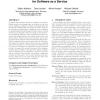Free Online Productivity Tools
i2Speak
i2Symbol
i2OCR
iTex2Img
iWeb2Print
iWeb2Shot
i2Type
iPdf2Split
iPdf2Merge
i2Bopomofo
i2Arabic
i2Style
i2Image
i2PDF
iLatex2Rtf
Sci2ools
103
click to vote
SIGMOD
2009
ACM
2009
ACM
A comparison of flexible schemas for software as a service
A multi-tenant database system for Software as a Service (SaaS) should offer schemas that are flexible in that they can be extended for different versions of the application and dynamically modified while the system is on-line. This paper presents an experimental comparison of five techniques for implementing flexible schemas for SaaS. In three of these techniques, the database"owns"the schema in that its structure is explicitly defined in DDL. Included here is the commonly-used mapping where each tenant is given their own private tables, which we take as the baseline, and a mapping that employs Sparse Columns in Microsoft SQL Server. These techniques perform well, however they offer only limited support for schema evolution in the presence of existing data. Moreover they do not scale beyond a certain level. In the other two techniques, the application "owns" the schema in that it is mapped into generic structures in the database. Included here are XML in DB2 and P...
| Added | 05 Dec 2009 |
| Updated | 05 Dec 2009 |
| Type | Conference |
| Year | 2009 |
| Where | SIGMOD |
| Authors | Stefan Aulbach, Dean Jacobs, Alfons Kemper, Michael Seibold |
Comments (0)

